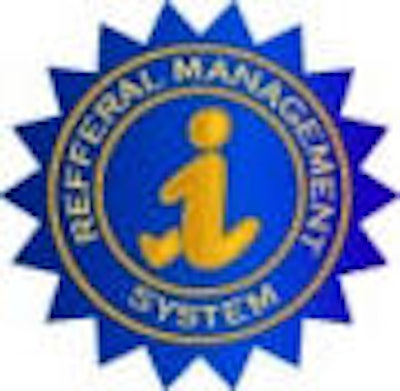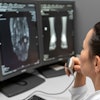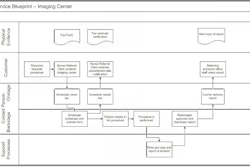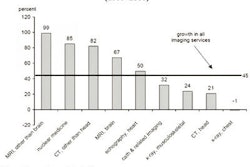

A service blueprint is basically a process map that visually portrays a service system. Process mapping is a frequently used tool in fields such as manufacturing, engineering, and construction, among others. Process maps can be used for something as simple as following the making of a wooden spoon to much more complex systems involving multiple tasks and parties. Service blueprints can also vary in size, scope, and detail. The key difference between a service blueprint and process map is the inclusion of the customer in a service blueprint. Because customers are often involved throughout the process, they are an integral part of the success.
The first step in completing a blueprint is determining the process and the customer. In most cases, the process will include everything from the point the patient is referred for a reading to sending the completed report back to the referring physician, but this is not a hard, fast rule.
The level of detail will depend on the objective of doing the blueprint in the first place. If it is to speed up the scheduling process, then more detail may be needed to focus on this portion. The primary customer is usually the referring physician or his office staff. They are the parties that heavily influence the referral volume to your organization. If the process is simple for them and they are satisfied with each of the steps, then they will refer more patients to your facility.
Below is an example of a blank template you can use to begin the blueprinting. While you can use a software tool such as Visio (Microsoft, Redmond, WA) for blueprinting, it is sometimes more effective to assemble a team and work collectively on paper so that everyone can see the results. It may seem like a small detail, but it is helpful in making everyone feel involved in the process.
Click here to view a template of a service blueprint.
The key components of service blueprints are customer actions, "onstage" contact employee actions, "backstage" contact employee actions, and support processes. Each of these components is placed down the edge of the blueprint and is separated by three horizontal lines. These are called action areas.
Events are placed within these action areas. You can use any symbols you want for each action. In most cases, a square is sufficient to house the description of each action. The boxes, or events, are connected to each other.
The first horizontal line separating the action areas is the line of interaction. A vertical line represents any customer (in this example, the referring physician's scheduler) action and whenever a vertical line crosses the horizontal line of interaction, a service encounter has occurred.
The next horizontal line is the line of visibility. Anything that happens behind this line is something that moves the process along, but the customer does not see. For example, the action of moving the film or image to the radiologist and the radiologist providing dictation to a system or transcriptionist is something that affects the overall process, but the customer never actually sees. Backstage actions are still important, however. Even though customers don't see what is happening, they feel the effects.
The third line is the line of internal interaction. This separates contact employee activities (answering phones and talking with physicians, couriers delivering reports, and so on) from those of other service support activities and people (such as a radiologist reading film, a rad tech conducting procedure prep, and so on). At the top of the blueprint is physical evidence of the service (such as a Web site, faxed forms, or completed reports).
Once your organization has completed the blueprint of the current process, it's time to review it with all of the parties involved, and ensure each party's role in the service delivery process matches up with what they do.
Remember, the blueprint itself is only one of the benefits of building it. Delineation of roles and responsibilities and development of a common service goal are actually benefits that are gained while performing the construction. After completion, it is time to analyze each of the service encounters (vertical lines). Are there ways to make the interactions more convenient? Is it possible to strengthen the interaction and lock in the referral business?
Much of the interaction between referring physicians and imaging centers comes in the scheduling and report delivery processes. By simplifying them and making them more convenient (such as eliminating phone wait time or eliminating lost scheduling request faxes by using secure, electronic methods), you are actually making life easier for referring physicians' offices. Pads of paper and cookies are nice too.
If you can use a service blueprint to improve efficiency for your customers, the results will be much more noticeable. A blueprint is merely a map to achieve the results your organization ultimately wants: better service, improved efficiency, and increased referrals -- and it's much easier to reach your destination if you have a map to guide you.
By Devin Colvin
AuntMinnie.com contributing writer
August 26, 2005
Devin Colvin is vice president of marketing for iAtrogenix, a company that provides referral management system (RMS) software for healthcare providers. For more information about iAtrogenix, please visit the company's Web site.
Related Reading
Strong customer relationships: Building a competitive advantage, June 6, 2005
VC practice thrives in Wisconsin, May 10, 2005
PACS improves care, builds interhospital relationships, March 14, 2005
Web-based workflow and reporting systems keep imaging on track, March 10, 2005
Automated report tracking serves clinical, educational goals, January 18, 2005
Copyright © 2005 iAtrogenix



















